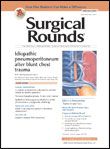Improving Outcomes for Ruptured Abdominal Aortic Aneurysm
Although ruptured abdominal aortic aneurysm is rare and usually asymptomatic, it is a rapidly life-threatening condition with outcomes that differ greatly by country.

Although ruptured abdominal aortic aneurysm (rAAA) is rare and usually asymptomatic, it is a rapidly life-threatening condition with outcomes that differ greatly by country.
The March 2014 issue of Lancet looked at the differences in rAAA outcomes between the United States and England with an eye toward improving care. Using the United States’ Nationwide Inpatient Sample and England’s equivalent database, the Hospital Episode, the paper analyzed data for all patients admitted to a hospital with rAAA from 2005 to 2010, comparing in-hospital mortality, mortality after intervention, and the decision to follow non-corrective treatment.
Both databases contained large numbers of rAAA records; in the US, the researchers found 23,838 patients, and in England, they identified 11,799 patients.
According to the study authors, patient mortality was significantly lower in the US than England. Additionally, American surgeons were more than twice as likely to offer open or endovascular repair than English surgeons, with surgeons discussing repair with more than 80% of patients in the US. As a result, patients were more likely to opt for endovascular repair in the US than in England. English patients were more likely to receive non-corrective treatment, or supportive care without open surgical or endovascular rAAA repair.
Both countries had similar rates of post-intervention mortality, with approximately 42% of patients dying. However, more American patients were discharged to rehabilitative facilities than English patients, who were more likely to be discharged to home. All patients were less likely to die if they underwent endovascular repair, were admitted on a weekday, or were treated in a hospital with a higher rAAA operative volume, bed capacity, or teaching status.
The researchers determined in-hospital survival, intervention rates, and uptake of endovascular repair were lower in England than the US. In both counties, patients treated in larger teaching hospitals that performed many rAAA repairs had better outcomes than others. They suggested England’s overall survival from rAAA would improve if UK surgeons offered interventions to a greater proportion of patients — a belief that is consistent with other published clinical data indicating that aggressive management decreases overall mortality from rAAA.
